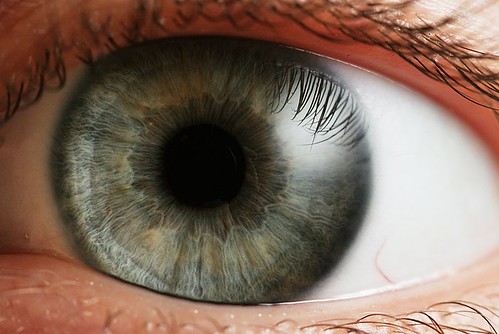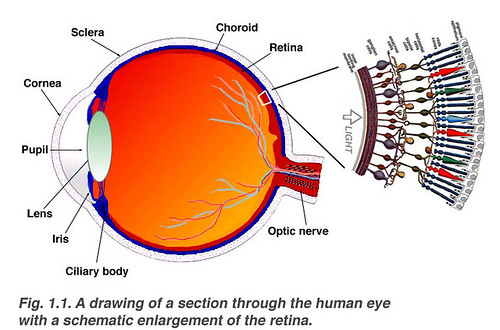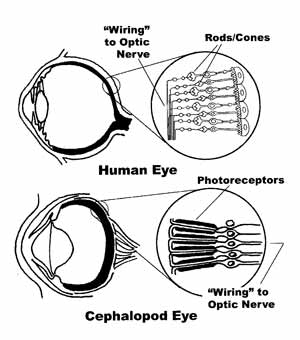tags: Ask a Science Blogger, vertebrate eye, molluscan eye
Image: Wikipedia. [larger view].
The newest "Ask a Science Blogger" question is; Which parts of the human body could you design better?
 Since I have only 500 words or so to explain, I will discuss only one anatomical feature: I would choose to redesign the vertebrate eye so the microscopic structure of the retina more closely resembles that of the molluscan eye.
Since I have only 500 words or so to explain, I will discuss only one anatomical feature: I would choose to redesign the vertebrate eye so the microscopic structure of the retina more closely resembles that of the molluscan eye.
On causal observation, the vertebrate eye appears to be similar to the cephalopod eye (cephalopods are often thought of as the "classical" mollusc), however, a more careful examination reveals that the vertebrate eye is designed in a way that is counter-intuitive for its function. In short, the vertebrate eye is "backwards". By this, I mean that the nerves and blood vessels that support the photoreceptors are actually located between the incoming light photons and the photosensitive rods and cones. As a result, some of the incoming photons are absorbed by these other structures and thus, do not interact with the photoreceptors at all.
How does light pass into and through the vertebrate eye so it ultimately interacts with light sensitive neurons? Light enters the vertebrate eye by passing through the cornea, which focusses the light, then passing through the iris, which controls light intensity by regulating how much will enter the eye, and then passing through the lens, which also focusses light (but unlike the cornea, is adjustable and is under conscious control). Light photons are thus focused onto the retina, a thin layer of tissue on the back of the eye. When light reaches the retina, it passes through a layer of neurons and blood vessels before it finally interacts with the photoreceptors. These photoreceptors, the rods and cones, transduce light photons into electrical signals that are transmitted through a series of neurons to the visual regions of the brain. Once in the brain, these signals are deciphered and integrated into a complete visual picture.
The "blind spot" is a structural peculiarity associated with the vertebrate eye. The reason is that, after being transduced by the rods and cones into electrical signals, known as "action potentials", the retinal neurons carry visual information to the visual cortex of the brain through a series of neurons, beginning with the bipolar cells, and progressing through the amacrine and ganglion cells. The ganglion cells' axons converge into the optic nerve, which sends these axonal projections into the visual cortex. Because there are no photoreceptors located above the optic nerve, the eye cannot perceive light at this point, and so the optic nerve is the source of the "blind spot" in the vertebrate eye (see figure, below);
Image: University of Utah, John Moran Eye Center [larger view].
In contrast, a molluscan eye, as exemplified by cephalopods, is more straighforward than the vertebrate eye. Molluscan photoreceptors are actually oriented towards incoming light while the supporting neurons and blood vessels lie beneath them. Thus, light photons interact with the light-sensitive rods and cones without first encountering any interference from these support structures. Further, the neural tracks are found beneath the photoreceptive layer of the eye and do not converge together into an optic nerve, which prevents molluscs from having a "blind spot" (see figure below);
The Eye and Retinal Structure of a Vertebrate and Cephalopod.
Image: Halder, G., P. Callaerts, and W.J. Gehring. "New Perspectives on Eye Evolution". Current Opinions In Genetics & Development 5:602-60 (1995).
So unlike molluscan eyes, vertebrate eyes are less efficient at perceiving light because photons must pass through several light-insensitive structures before reaching photoreceptors at the back of the eye, and also, because of the "wiring" of the vertebrate retina, there is a blind spot where nothing can be seen at all.
Eyes are a beautiful example of convergent evolution. While vertebrate and molluscan (and also insect) eyes are clearly light-sensitive organs that have demonstrably solved the same evolutionary challenge in their own unique ways, they all arose independently and thus, are very different structures with different developmental trajectories and evolutionary histories.
- Log in to post comments




The vert eye has cells called Muller cells which get round its incompetent design by acting as living optic fibres that funnel light through the morass of nerves and blood vessels to the underlying photoreceptors.
The drawback to the vertebrate eye isn't just the additional complexity (who cares?) or the blind spot (rarely noticed), but that it exposes us to greater disease risk, including a variety of retinal diseases leading to blindness. They don't occur frequently. And it doesn't much impact our reproductive success if a small fraction of the elderly go blind. But it's certainly not the ideal way for things to be.
I would redesign the nervous system to have some redundancy. I currently have a neuropathy that results in partial paralysis in my arms and hands. A network with multiple possible routes for messages, like the internet, would eliminate much of my current problem.
Since this was caused by an autoimmune attack on my nerves, I think the rubegoldbergian immune system could use a major redesign.
Anyone who believes in Intelligent Design believes in an inept god.
I'd redesign the immune system to accept external direction, via suitably supplied samples: "Attack cells with these antigens", and also "suppress response against this antigen". While we're at it, how about "output listing/samples of current targets, with current status of each effort"....
IIRC insufficient cooling of the retina is a sometime hazard, as the blood flow is restricted. While a molluscan design avoids that as well.
Knees. Enough said.
I too would redesign knees. They invariably seem to get messed up. My sister is only 28 and has had one knee surgery and probably needs another. All she did was participate in gymnastics throughout elementary school.
But your answer (although this English major didn't understand it) is better, simply because knees are probably what most people would've said. The eye was pretty clever, I thought.
The vermiform appendix, one of the best arguments for evolution that I've seen. Why do we still have one? One leading hypothesis is that for evolution to get rid of it, it would first have to make it smaller - and a smaller appendix would get stopped that much more often, leading to more deaths from appendicitis - a selective pressure to keep the damned thing.
While we're on it, I'd give us an intact copy of the gene for L-gluconolactone oxidase. Pseudogene ΨGULO explains why only the higher primates can get scurvy.
I would say backs. When I hear people refuting intelligent design they often bring up the problems people have with their backs to show how badly our backs are designed.
thanks for your comments, everyone! very interesting thoughts (and information, too).
If only there was a way to have the nervous system wired such that one can consciously shut off pain receptors.
Pain does have an adaptive function, warning us of impending danger or that something is wrong with our bodies, but there have been so many occasions when I wish I could divert pain reception from certain parts of my body, especially when I get mouth ulcers.
I think we have more of a blind spot than the one mentioned. Since we cannot see anything except what is directly in front of us, that leaves us vulnerable to attacks from behind. I would redesign our heads so we had better vision or more eyeballs. That sounds gross but if everyone had them, it wouldn't be so different!
And why do people have to bring God into this? You don't have to bag on other people's religions to make your point.